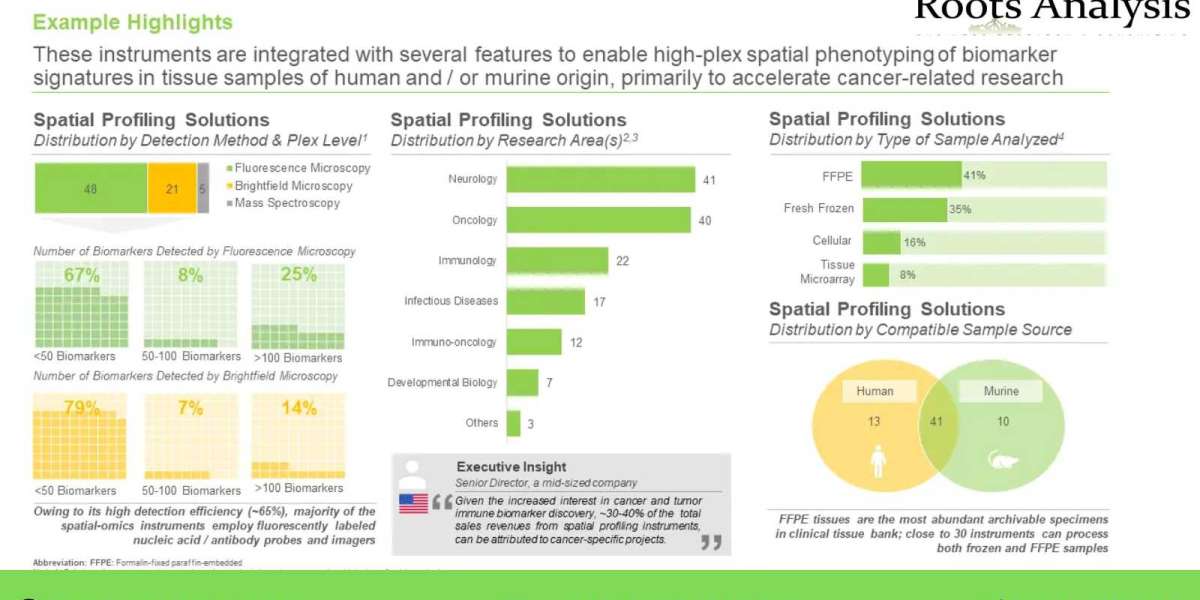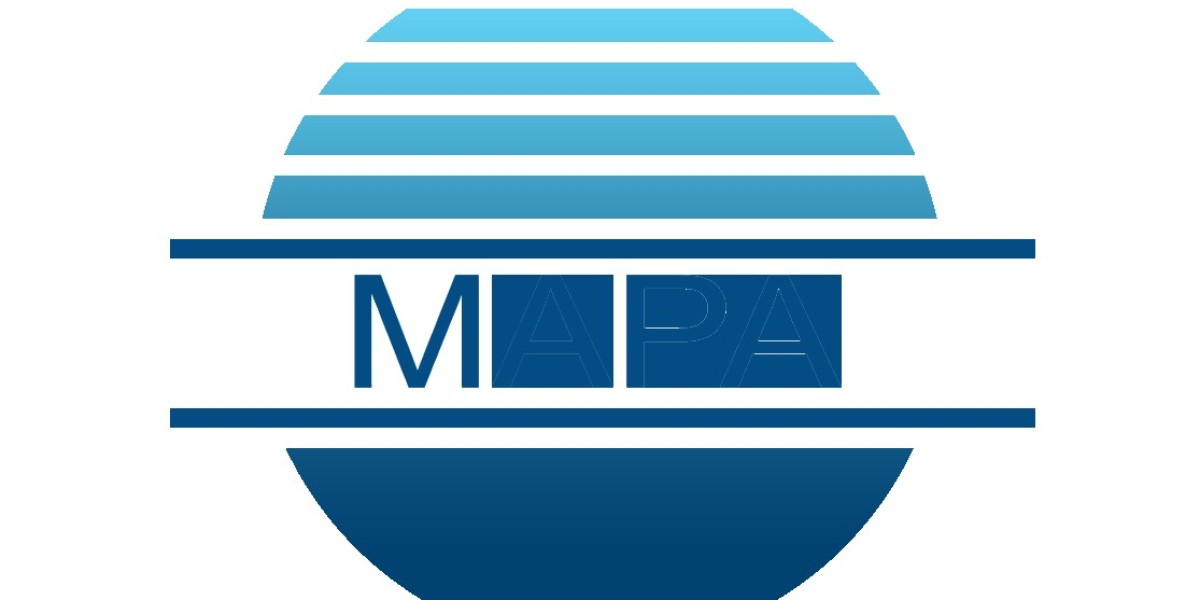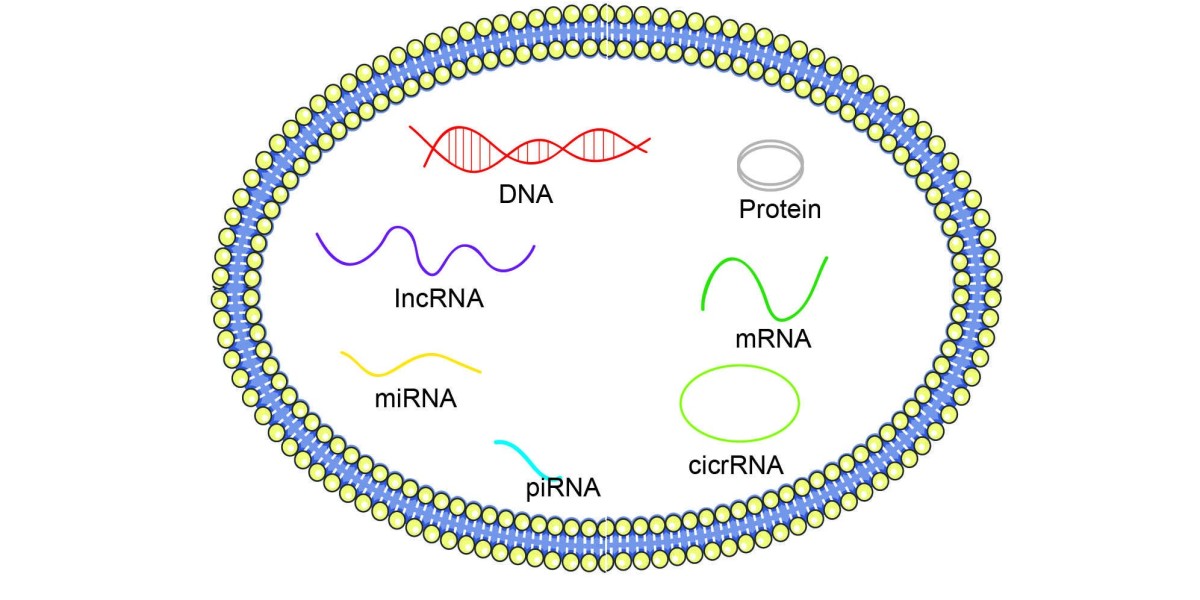Key Market Insights
- Presently, more than 70 spatial omics solutions are either commercialized / underdeveloped for the spatial phenotyping and spatial profiling of cellular landscape.
- 45 industry and non-industry players claim to offer spatial genomics, transcriptomics and proteomics solutions.
- Majority (72%) of the solution providers are based in North America, followed by those headquartered in Europe (22%). A large proportion (50%) of these companies are large players, followed by small (30%) and mid-sized firms (20%).
- The rising interest in this rapidly evolving domain can be validated by the partnerships inked in recent years; majority of the deals were signed for technology / platform integration purposes
- Grants worth over USD 20 million have been awarded to support research on spatial omics solutions, since 2018, of which, 38% of the total number of grants were provided by the National Institutes of Health (NIH).
- North America is anticipated to capture larger share of market by 2035 and is estimated to be worth USD 9.61 billion by 2035, growing at a CAGR of 11.5%.
- Our estimates suggest that the overall market is likely to be driven by the revenues generated through the sales of spatial omics instruments in the foreseen future due to their high cost. Further, the share of consumables and software is expected to grow at a relatively faster pace (12.7%), during the given period.
Table of Contents
- PREFACE
1.1. Scope of the Report
1.2. Research Methodology
1.3. Key Questions Answered
1.4. Chapter Outlines
- EXECUTIVE SUMMARY
- INTRODUCTION
3.1. Chapter Overview
3.2. Overview of Spatial Biology
3.3. Overview of Spatial Omics Solutions
3.2.1. Historical Overview of Spatial Omics Solutions
3.2.2. Features of Spatial Omics Solutions
3.2.3. Workflow of Spatial Omics Instruments
3.2.4. Computational Methods for Spatial Omics
3.2.5. Application Areas of Spatial Omics
3.4. Concluding Remarks
- SPATIAL OMICS SOLUTIONS: MARKET LANDSCAPE
4.1. Chapter Overview
4.2. List of Spatial Omics Solutions
4.2.1. Analysis by Commercial Availability
4.2.2. Analysis by Type of Solution(s) Offered
4.2.3. Analysis by Type of Sample(s) Analyzed
4.2.4. Analysis by Supporting Labware
4.2.5. Analysis by Type of Molecule(s) Analyzed
4.2.6. Analysis by Detection Method(s) Used
4.2.7. Analysis by Maximum Plex Level
4.2.8. Analysis by Quantification Capability
4.2.9. Analysis by Research Area(s)
4.2.10. Analysis by Application Area(s)
4.2.11. Analysis by Compatible Sample Source(s)
4.2.12 Analysis by Compatible Sample Source(s) and Type of Sample(s) Analyzed
4.2.13 Analysis by Quantification Capability and Type of Molecule(s) Analyzed
4.2.13 Analysis by Detection Method(s) Used and Maximum Plex Level
4.3. Spatial Omics Solution Providers: List of Players
4.3.1. Analysis by Type of Players
4.3.2. Analysis by Year of Establishment
4.3.3. Analysis by Player Size
4.3.4. Analysis by Location of Headquarters
4.3.5. Analysis by Company Ownership
4.3.6. Analysis by Year of Establishment and Location of Headquarters
4.3.7. Analysis by Player Size and Location of Headquarters
4.3.8. Analysis by Leading Players
4.4. Spatial Omics Solutions: List of Kits
4.5. Spatial Omics Solutions: Funding and Investments
- SPATIAL OMICS SOLUTION PROVIDERS: PRODUCT COMPETITIVENESS ANALYSIS
5.1 Chapter Overview
5.2 Assumptions / Key Parameters
5.3 Methodology
5.4 Product Competitiveness Analysis: Spatial Omics Solution Providers
5.4.1 Peer Group I: Small Companies
5.4.2. Peer Group II: Mid-sized Companies
5.4.3. Peer Group III: Large Companies
- SPATIAL OMICS SOLUTIONS: COMPANY PROFILES
6.1. Chapter Overview
6.2. Spatial Omics Analysis Solution Providers: North America
6.2.1. 10X Genomics
6.2.1.1. Company Overview
6.2.1.2. Financial Information
6.2.1.3. Product Portfolio
6.2.1.4. Recent Developments and Future Outlook
6.2.2. Akoya Biosciences
6.2.2.1. Company Overview
6.2.2.2. Financial Information
6.2.2.3. Product Portfolio
6.2.2.4. Recent Developments and Future Outlook
6.2.3. Bruker
6.2.3.1. Company Overview
6.2.3.2. Financial Information
6.2.3.3. Product Portfolio
6.2.3.4. Recent Developments and Future Outlook
6.2.4. Canopy Biosciences
6.2.4.1. Company Overview
6.2.4.2 Financial Information
6.2.4.3. Product Portfolio
6.2.4.4. Recent Developments and Future Outlook
6.2.5. NanoString Technologies
6.2.5.1. Company Overview
6.2.5.2. Product Portfolio
6.2.5.3. Recent Developments and Future Outlook
6.2.6. Vizgen
6.2.6.1. Company Overview
6.2.6.2. Product Portfolio
6.2.6.3. Recent Developments and Future Outlook
6.3. Spatial Omics Analysis Solution Providers: Europe
6.3.1. Lunaphore Technologies
6.3.1.1. Company Overview
6.3.1.2. Product Portfolio
6.3.1.3. Recent Developments and Future Outlook
6.3.2. Molecular Machines Industries (MMI)
6.3.2.1. Company Overview
6.3.2.2. Product Portfolio
6.3.2.3. Recent Developments and Future Outlook
6.3.3. Resolve Biosciences
6.3.3.1. Company Overview
6.3.3.2. Product Portfolio
6.3.3.3. Recent Developments and Future Outlook
- PARTNERSHIPS AND COLLABORATIONS
7.1. Chapter Overview
7.2. Partnership Models
7.3. Spatial Omics Solutions: List of Partnerships and Collaborations
7.3.1. Analysis by Year of Partnership
7.3.2. Analysis by Type of Partnership
7.3.3. Analysis by Type of Partner
7.3.4. Analysis by Year of Partnership and Type of Partner
7.3.5. Analysis by Type of Partnership and Type of Partner
7.3.6. Analysis by Therapeutic Area
7.3.7. Intercontinental and Intracontinental Agreements
7.3.8. Analysis by Regional Distribution
7.3.9. Most Active Players: Analysis by Number of Partnerships
- PATENT ANALYSIS
8.1. Chapter Overview
8.2 Scope and Methodology
8.3 Spatial Omics Solutions: Patent Analysis
8.3.1. Analysis by Application Year
8.3.2. Analysis by Publication Year
8.3.3. Analysis by Geography
8.3.4. Analysis by CPC Symbols
8.3.5. Word Cloud: Emerging Focus Areas
8.3.6. Analysis by Type of Applicant
8.3.7. Leading Players: Analysis by Number of Patents
8.3.8. Leading Patent Assignees: Analysis by Number of Patents
8.3.9. Spatial Omics Solutions: Patent Benchmarking Analysis
8.3.10. Spatial Omics Solutions: Patent Valuation
8.3.11. Leading Patents: Analysis by Number of Citations
- PUBLICATION ANALYSIS
9.1. Chapter Overview
9.2 Scope and Methodology
9.3. Spatial Omics Solutions: List of Publications
9.4.1. Analysis by Year of Publication (2001-2022)
9.4.2. Analysis by Year and Quarterly Trend of Publication (2015-2021)
9.4.3. Analysis by Month and Quarterly Trend of Publication (2015-2021)
9.4.4. Analysis by Type of Publication
9.4.5. Most Popular Journals: Analysis by Number of Publications
9.4.6. Most Popular Journals: Analysis by Journal Impact Factor
9.4.7. Most Popular Publishers: Analysis by Number of Publications
9.4.8. Most Popular Copyright Holder: Analysis by Number of Publications
9.4.9. Analysis by Popular Keywords
9.4.10. Most Popular Authors: Analysis by Number of Publications
9.4.11. Analysis by Affiliated Institutes
9.4.12. Analysis by Most Targeted Research Area
9.4.13. Analysis by Geography
- CASE STUDY ON POTENTIAL CLIENTS OF SPATIAL OMICS SOLUTION PROVIDERS
10.1. Chapter Overview
10.2. Live Cell Imaging Instruments Providers: Overall Market Landscape
10.2.1. Analysis by Year of Establishment
10.2.2. Analysis by Company Size
10.2.3. Analysis by Location of Headquarters
10.2.4. Analysis by Company Type
10.2.5. Analysis by Year of Establishment and Location of Headquarters
10.2.6. Analysis by Company Size and Location of Headquarters
10.3 Live Cell Imaging Instruments: List of Instruments
10.3.1. Year-Wise Distribution of Commercial Availability
10.3.2. Analysis by Microscope Weight
10.3.3. Analysis by Microscope Configuration
10.3.4. Analysis by Incubator Integrated and Environmental Parameters Controlled
10.3.5. Analysis by Supported Labware
10.3.6. Analysis by Mode of Imaging
10.3.7. Analysis by Multi-user Mode
10.3.8. Analysis by Z-stack Imaging Capability
10.3.9. Analysis by Availability of Autofocusing / Semi-Autofocusing Ability
10.3.10. Analysis by Mode of Imaging, Multi-user mode, Z-Stack Imaging and Autofocusing Semi-autofocusing Capability
10.3.11. Analysis by Number of Fluorescence Channels
10.3.12. Analysis by Magnification
- CASE STUDY ON SEQUENCING TECHNOLOGIES
11.1. Chapter Overview
11.2. Genome Sequencing Technologies: Overall Market Landscape
11.2.1. Analysis by Type of Sequencing Technique
11.2.2. Analysis by Maximum Output
11.2.3. Analysis by Maximum Reads per Run
11.2.4. Analysis by Method of Sequencing
11.3 Genome Sequencing Technology Providers: List of Technology Providers
11.3.1. Analysis by Year of Establishment
11.3.2. Analysis by Company Size
11.3.3. Analysis by Location of Headquarters
- SPATIAL OMICS SOLUTION PROVIDERS: MARKET FORECAST AND OPPORTUNITY ANALYSIS
12.1 Chapter Overview
12.2. Forecast Methodology and Key Assumptions
12.3. Global Spatial Omics Solutions Market, 2022-2035
12.3.1 Spatial Omics Solutions Market: Distribution by Type of Solution, 2022-2035
12.3.1.1 Spatial Omics Solutions Market for Instruments, 2022-2035
12.3.1.2 Spatial Omics Solutions Market for Services, 2022-2035
12.3.1.3 Spatial Omics Solutions Market for Consumables and Software, 2022-2035
12.3.2. Spatial Omics Solutions Market: Distribution by Type of Sample Analyzed, 2022-2035
12.3.2.1 Spatial Omics Solutions Market for Proteins, 2022-2035
12.3.2.2 Spatial Omics Solutions Market for RNA, 2022-2035
12.3.2.3 Spatial Omics Solutions Market for DNA, 2022-2035
12.3.3. Spatial Omics Solutions Market: Distribution by Therapeutic Area, 2022-2035
12.3.3.1 Spatial Omics Solutions Market for Oncological and Immuno-Oncological Disorders, 2022-2035
12.3.3.2 Spatial Omics Solutions Market for Immunological Disorders, 2022-2035
12.3.3.3 Spatial Omics Solutions Market for Neurological Disorders, 2022-2035
12.3.3.4 Spatial Omics Solutions Market for Infectious Diseases, 2022-2035
12.3.3.5 Spatial Omics Solutions Market for Other Research Areas, 2022-2035
12.3.4. Spatial Omics Solutions Market: Distribution by End User, 2022-2035
12.3.4.1 Spatial Omics Solutions Market for Pharmaceutical and Biotechnology Companies, 2022-2035
12.3.4.2 Spatial Omics Solutions Market for Academic and Research Institutes, 2022-2035
12.3.5. Spatial Omics Solutions Market: Distribution by Region, 2022-2035
12.3.5.1 Spatial Omics Solutions Market in North America, 2022-2035
12.3.5.2 Spatial Omics Solutions Market in Europe, 2022-2035
12.3.5.3 Spatial Omics Solutions Market in Asia-Pacific and Rest of the World, 2022-2035
12.4. Spatial Omics Solutions Market for Instruments, 2022-2035
12.4.1. Spatial Omics Solutions Market for Instruments: Distribution by Type of Sample Analyzed, 2022-2035
12.4.2. Spatial Omics Solutions Market for Instruments: Distribution by Therapeutic Area, 2022-2035
12.4.3. Spatial Omics Solutions Market for Instruments: Distribution by End User, 2022-2035
12.4.4. Spatial Omics Solutions Market for Instruments: Distribution by Region, 2022-2035
12.5. Spatial Omics Solutions Market for Services, 2022-2035
12.5.1. Spatial Omics Solutions Market for Services: Distribution by Type of Sample Analyzed, 2022-2035
12.5.2. Spatial Omics Solutions Market for Services: Distribution by Therapeutic Area, 2022-2035
12.5.3. Spatial Omics Solutions Market for Services: Distribution by End User, 2022-2035
12.5.4. Spatial Omics Solutions Market for Services: Distribution by Region, 2022-2035
12.6. Spatial Omics Solutions Market for Consumables and Software, 2022-2035
12.6.1. Spatial Omics Solutions Market for Consumables and Software: Distribution by Type of Sample Analyzed, 2022-2035
12.6.2. Spatial Omics Solutions Market for Consumables and Software: Distribution by Therapeutic Area, 2022-2035
12.6.3. Spatial Omics Solutions Market for Consumables and Software: Distribution by End User, 2022-2035
12.6.4. Spatial Omics Solutions Market for Consumables and Software: Distribution by Region, 2022-2035
- EXECUTIVE INSIGHTS
- CONCLUDING REMARKS
- APPENDIX 1: TABULATED DATA
- APPENDIX 2: LIST OF COMPANIES AND ORGANIZATIONS
To view more details on this report, click on the link
https://www.rootsanalysis.com/reports/spatial-genomics-market.html
You may also be interested in the following titles:
You may also like to learn what our experts are sharing in Roots educational series:
T-cell Immunotherapies: The Future of Modern Cancer Treatments |
About Roots Analysis
Roots Analysis is a global leader in the pharma / biotech market research. Having worked with over 750 clients worldwide, including Fortune 500 companies, start-ups, academia, venture capitalists and strategic investors for more than a decade, we offer a highly analytical / data-driven perspective to a network of over 450,000 senior industry stakeholders looking for credible market insights.
Contact:
Ben Johnson
+1 (415) 800 3415



